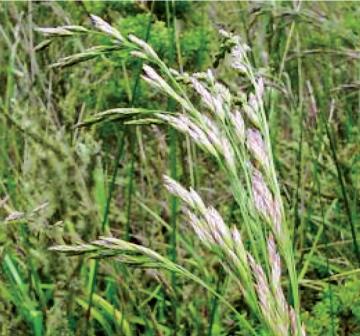
Tall fescue (Festuca arundinacea)
Local name: Tall fescue
The fescues (Festuca spp.) compose a large genus of about 100 species of grasses. Tall fescue is a deep rooted, cool season perennial grass. The plant produces vigorous growth in the spring and fall and its extensive root system helps it withstand drought conditions. Tall fescue does produce short rhizomes but has a bunch-type growth habit; it spreads primarily by erect tillers. Individual tillers, or stems, terminate in an inflorescence, reach 3-4 feet in height, and have broad, dark green basal leaves. Leaf blades are glossy on the underside and serrated on the margins. The leaf sheath is smooth and the ligule is a short membrane. The inflorescence is a compact panicle, 3-4 inches long with lanceolate spikelets one-half inch or longer. The grass flowers in the spring and seed mature in early summer. Seed are 4-7 mm long, elliptic and awned. It is a high yielding perennial grass which grows very well on rich moist soil.
Nutritive value
It stands high alkalinity but is not palatable to livestock when it grows tall. It is grown for forage, hay and silage and soil improvement and conservation. It is also used as an ornamental grass. It contains about 9% crude protein and 28% crude fibre.
